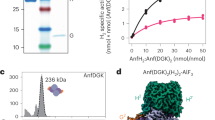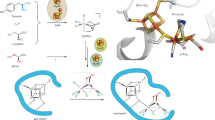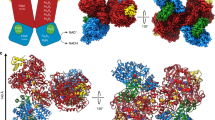Abstract
The crystal structure of the tetrameric α2β2 acetyl-coenzyme A synthase/carbon monoxide dehydrogenase from Moorella thermoacetica has been solved at 1.9 Å resolution. Surprisingly, the two α subunits display different (open and closed) conformations. Furthermore, X-ray data collected from crystals near the absorption edges of several metal ions indicate that the closed form contains one Zn and one Ni at its active site metal cluster (A-cluster) in the α subunit, whereas the open form has two Ni ions at the corresponding positions. Alternative metal contents at the active site have been observed in a recent structure of the same protein in which A-clusters contained one Cu and one Ni, and in reconstitution studies of a recombinant apo form of a related acetyl-CoA synthase. On the basis of our observations along with previously reported data, we postulate that only the A-clusters containing two Ni ions are catalytically active.
This is a preview of subscription content, access via your institution
Access options
Subscribe to this journal
Receive 12 print issues and online access
$189.00 per year
only $15.75 per issue
Buy this article
- Purchase on Springer Link
- Instant access to full article PDF
Prices may be subject to local taxes which are calculated during checkout





Similar content being viewed by others
References
Huber, C. & Wachtershauser, G. Activated acetic acid by carbon fixation on (Fe, Ni)S under primordial conditions. Science 276, 245–247 (1997).
Wood, H.G. & Ljungdahl, L.G Autotrophic character of acetogenic bacteria. in Variation in Autotrophic Life (eds. Shively, J.M. & Barton, L.L.) 201–250 (Academic Press, New York; 1991).
Dobbek, H., Svetlitchnyi, V., Gremer, L., Huber, R. & Meyer, O. Crystal structure of a carbon monoxide dehydrogenase reveals a [Ni-4Fe-5S] cluster. Science 293, 1281–1285 (2001).
Drennan, C.L., Heo, J., Sintchak, M.D., Schreiter, E. & Ludden, P.W. Life on carbon monoxide: X-ray structure of Rhodospirillum rubrum Ni-Fe-S carbon monoxide dehydrogenase. Proc. Natl. Acad. Sci. USA 98, 11973–11978 (2001).
Lindahl, P.A., Munck, E. & Ragsdale, S.W. CO dehydrogenase from Clostridium thermoaceticum. EPR and electrochemical studies in CO2 and argon atmospheres. J. Biol. Chem. 265, 3873–3879 (1990).
Maynard, E.L. & Lindahl, P.A. Evidence of a molecular tunnel connecting the active sites for CO2 reduction and acetyl-CoA synthesis in acetyl-CoA synthase from Clostridium thermoaceticum. J. Am. Chem. Soc. 121, 9221–9222 (1999).
Seravalli, J. & Ragsdale, S.W. Channeling of carbon monoxide during anaerobic carbon dioxide fixation. Biochemistry 39, 1274–1277 (2000).
Doukov, T.I., Iverson, T.M., Seravalli, J., Ragsdale, S.W. & Drennan, C.L. A Ni-Fe-Cu center in a bifuctional carbon monoxide dehydrogenase/acetyl-CoA synthase. Science 298, 567–572 (2002).
Lu, W.P., Harder, S.R. & Ragsdale, S.W. Controlled potential enzymology of methyl transfer reactions involved in acetyl-CoA synthesis by CO dehydrogenase and the corrinoid/iron-sulfur protein from Clostridium thermoaceticum. J. Biol. Chem. 265, 3124–3133 (1990).
Barondeau, D.P. & Lindahl, P.A. Methylation of carbon monoxide dehydrogenase from Clostridium thermoaceticum and the mechanism of acetyl-CoA synthesis. J. Am. Chem. Soc. 119, 3959–3970 (1997).
Ragsdale, S.W. & Wood, H.G. Acetate biosynthesis by acetogenic bacteria. Evidence that carbon monoxide dehydrogenase is the condensing enzyme that catalyzes the final steps of the synthesis. J. Biol. Chem. 260, 3970–3977 (1985).
Tucci, G.C. & Holm, R.H. Nickel-mediated formation of thio esters from bound methyl, thiols, and carbon monoxide: a possible reaction pathway of acetyl-coenzyme A synthase activity in nickel-containing carbon monoxide dehydrogenases. J. Am. Chem. Soc. 117, 6489–6496 (1995).
Montet, Y. et al. Gas access to the active site of Ni-Fe hydrogenases probed by X-ray crystallography and molecular dynamics. Nat. Struct. Biol. 4, 523–526 (1997).
Shin, W. & Lindahl, P.A. Function and CO binding properties of the NiFe complex in carbon monoxide dehydrogenase from Clostridium thermoaceticum. Biochemistry 31, 12870–12875 (1992).
Tan, X.S., Sewell, C., Yang, Q. & Lindahl, P.A. Reduction and methyl transfer kinetics of the α subunit from acetyl-coenzyme A synthase. J. Am. Chem. Soc. 125, 318–319 (2003).
Tan, X.S., Sewell, C. & Lindahl, P.A. Stopped-flow kinetics of methyl group transfer between the corrinoid-iron-sulfur protein and acetyl-coenzyme A synthase from Clostridium thermoaceticum. J. Am. Chem. Soc. 124, 6277–6284 (2002).
Ragsdale, S.W., Ljungdahl, L.G. & Dervartanian, D.V. 13C and 61Ni isotope substitutions confirm the presence of a nickel(III)-carbon species in acetogenic CO dehydrogenases. Biochem. Biophys. Res. Commun 115, 658–665 (1983).
Ragsdale, S.W., Wood, H.G. & Antholine, W.E. Evidence that an iron-nickel-carbon complex is formed by reaction of carbon monoxide with the carbon monoxide dehydrogenase from Clostridium thermoaceticum. Proc. Natl. Acad. Sci. USA 82, 6811–6814 (1985).
Xia, J. & Lindahl, P.A. Assembly of an exchange-coupled [Ni:′Fe4S4] cluster in the α metallosubunit of CO dehydrogenase from Clostridium thermoaceticum with spectroscopic properties and CO-binding ability mimicking those of the acetyl-CoA synthase active site. J. Am. Chem. Soc. 118, 483–484 (1996).
Russell, W.K., Stålhandske, C.M.V., Xia, J., Scott, R.A. & Lindahl, P.A. Spectroscopic, redox and structural characterization of the Ni-labile and nonlabile forms of the acetyl-CoA synthase active site of CO dehydrogenase. J. Am. Chem. Soc. 120, 7502–7510 (1998).
Shin, W., Anderson, M.E. & Lindahl, P.A. Heterogeneous nickel environments in carbon monoxide dehydrogenase from Clostridium thermoaceticum. J. Am. Chem. Soc. 115, 5522–5526 (1993).
Shin, W. & Lindahl, P.A. Low spin quantitation of NiFeC EPR signal from carbon monoxide dehydrogenase is not due to damage incurred during protein purification. Biochim. Biophys. Acta 1161, 317–322 (1993).
Lindahl, P.A., Ragsdale, S.W. & Münck, E. Mössbauer study of CO dehydrogenase from Clostridium thermoaceticum. J. Biol. Chem. 265, 3880–3888 (1990).
Wilson, B.E. & Lindahl, P.A. Equilibrium dialysis study and mechanistic implications of coenzyme A binding to acetyl-CoA synthase/carbon monoxide dehydrogenase from Clostridium thermoaceticum. J. Biol. Inorg. Chem. 4, 742–748 (1999).
Musie, G., Farmer, P.J., Tuntulani, T., Reibenspies, J.H. & Darensbourg, M.Y. Influence of sulfur metalation on the accessibility of the NiII/I couple in [N, N′-Bis(2-mercaptoethyl)-1,5-diazacyclootanato]nickel(II): insight into the redox properties of [NiFe]-hydrogenase. Inorg. Chem. 35, 2176–2183 (1996).
Lai, C.-H., Reibenspies, J.H. & Darensbourg, M.Y. Thiolate bridged nickel-iron complexes containing both iron(0) and iron(II) carbonyls. Angew. Chem. Int. Ed. Engl. 35, 2390–2393 (1996).
Bouwman, E., Henderson, R.K., Spek, A.L. & Reedijk, J. Spontaneous assembly of a novel tetranuclear Ni-Fe complex by complete reshuffling of ligands and oxidation states. Eur. J. Inorg. Chem. 1999, 217–219 (1999).
Tolman, C.A. Electron donor-acceptor properties of phosphorus ligands. Substituent additivity. J. Am. Chem. Soc. 92, 2953–2956 (1970).
Shultz, C.S., DeSimone, J.M. & Brookhart, M. Four- and five-coordinate CO insertion mechanisms in d8-nickel(II) complexes. J. Am. Chem. Soc. 123, 9172–9173 (2001).
Tolman, C.A., Seidel, W.C. & Gosser, L.W. Formation of three-coordinate nickel(0) complexes by phosphorus ligand dissociation from NiL4 . J. Am. Chem. Soc. 96, 53–60 (1973).
Hsiao, Y.-M., Chojnacki, S.S., Hinton, P., Reibenspies, J.H. & Darensbourg, M.Y. Organometallic chemistry of sulfur/phosphorus donor ligand complexes of nickel(II) and nickel(0). Organometallics 12, 870–875 (1993).
Cotton, F.A. & Wilkinson, G. The chemistry of the transition elements. in Advanced Inorganic Chemistry 5th edn. 741–754 (Wiley, New York; 1997).
Volbeda, A. et al. Structure of the (NiFe) hydrogenase active site: evidence for biologically uncommon Fe ligands. J. Am. Chem. Soc. 118, 12989–12996 (1996).
Fan, C., Gorst, C.M., Ragsdale, S.W. & Hoffman, B.M. Characterization of the nickel-iron-carbon complex formed by reaction of carbon monoxide with the carbon monoxide dehydrogenase from Clostridium thermoaceticum by Q-band ENDOR. Biochemistry 30, 431–435 (1991).
Collman, J.P., Hegedus, L.S., Norton, J.R. & Finke, R.G. Intramolecular insertion reactions. in Principles and Applications of Organotransition Metal Chemistry 355–399 (University Science Books, Mill Valley; 1987).
Gencic, S. & Grahame, D.A. Nickel in subunit β of the acetyl-CoA decarbonylase/synthetase multienzyme complex in methanogens. J. Biol. Chem. 278, 6101–6110 (2003).
Lundie, L.L. Jr. & Drake, H.L. Development of a minimally defined medium for the acetogen Clostridium thermoaceticum. J. Bacteriol. 159, 700–703 (1984).
Vernède, X. & Fontecilla-Camps, J.C. A method to stabilize reduced and/or gas-treated protein crystals by flash-cooling under a controlled atmosphere. J. Appl. Crystallogr. 32, 505–509 (1999).
Kabsch, W. Integration, scaling, space-group assignment and post refinement. in International Tables for Crystallography, Volume F, Crystallography of Biological Macromolecules (eds. Rossmann, M.G. & Arnold, E.) Ch. 11.3 (Kluwer Academic Publishers, Dordrecht; 2001).
Navaza, J. AMoRe: an automated package for molecular replacement. Acta Crystallogr. A 50, 157–163 (1994).
Terwilliger, T.C. & Berendzen, J. Automated structure solution for MIR and MAD. Acta Crystallogr. D 55, 849–861 (1999).
Read, R.J. Improved Fourier coefficients for maps using phases from partial structures with errors. Acta Crystallogr. A 42, 140–149 (1986).
Terwilliger, T.C. Map-likelihood phasing. Acta Crystallogr. D 57 1763–1775 (2001).
Perrakis, A., Morris, R.J. & Lamzin, V.S. Automated protein model building combined with iterative structure refinement. Nat. Struct. Biol. 6, 458–463 (1999).
Roussel, A. & Cambillau, C. Turbo-Frodo (Silicon Graphics, Mountain View; 1989).
Murshudov, G.N., Vagin, A.A. & Dodson, E.J. Refinement of macromolecular structures by the maximum-likehood method. Acta Crystallogr. D 53, 240–255 (1997).
Winn, M.D., Isupov, M.N. & Murshudov, G.N. Use of TLS parameters to model anisotropic displacements in macromolecular refinement. Acta Crystallogr. D 57, 122–133 (2001).
Volbeda, A. Spéléologie des hydrogenases à nickel et à fer. Les écoles physique et chimie du vivant 1, 47–52 (1999).
Collaborative Computational Project, Number 4. The CCP4 suite: programs for protein crystallography. Acta Crystallogr. D 50, 760–763 (1994).
Kraulis, P.J. MOLSCRIPT: a program to produce both detailed and schematic plots of protein structures. J. Appl. Crystallogr. 24, 946–950 (1991).
Merritt, E.A. & Bacon, D.J. Raster3D: photorealistic molecular graphics. Methods Enzymol. 277, 505–524 (1997).
Lawrence, M.C. & Bourke, P. A program for generating electron density isosurfaces from Fourier syntheses in protein crystallography. J. Appl. Crystallogr. 33, 990–991 (2000).
Acknowledgements
We thank T. Rabilloud for preparing the NDSB195 reagent and M.Y. Darensbourg for helpful discussion about the feasibility of a Nip0 state. This study was supported by the Robert A. Welch Foundation, the National Institutes of Health and by the CEA and the CNRS through institutional funding. We also thank L. Martin for excellent technical help. We appreciate the help with X-ray data collection from the following scientists working at the European Synchrotron Radiation Facility: L. Jacquamet and M. Pirocchi (LCCP and BM30), J. McCarthy (ID14EH1) and G. Sainz (ID29).
Author information
Authors and Affiliations
Corresponding author
Ethics declarations
Competing interests
The authors declare no competing financial interests.
Rights and permissions
About this article
Cite this article
Darnault, C., Volbeda, A., Kim, E. et al. Ni-Zn-[Fe4-S4] and Ni-Ni-[Fe4-S4] clusters in closed and open α subunits of acetyl-CoA synthase/carbon monoxide dehydrogenase. Nat Struct Mol Biol 10, 271–279 (2003). https://doi.org/10.1038/nsb912
Received:
Accepted:
Published:
Issue Date:
DOI: https://doi.org/10.1038/nsb912
This article is cited by
-
Class III hybrid cluster protein homodimeric architecture shows evolutionary relationship with Ni, Fe-carbon monoxide dehydrogenases
Nature Communications (2023)
-
Ambient temperature CO2 fixation to pyruvate and subsequently to citramalate over iron and nickel nanoparticles
Nature Communications (2023)
-
Decorated Vesicles as Prebiont Systems (a Hypothesis)
Origins of Life and Evolution of Biospheres (2023)
-
The monofunctional CO dehydrogenase CooS is essential for growth of Thermoanaerobacter kivui on carbon monoxide
Extremophiles (2022)
-
Instant Cyclohexene Epoxidation Over Ni-TUD-1 Under Ambient Conditions
Catalysis Letters (2021)



